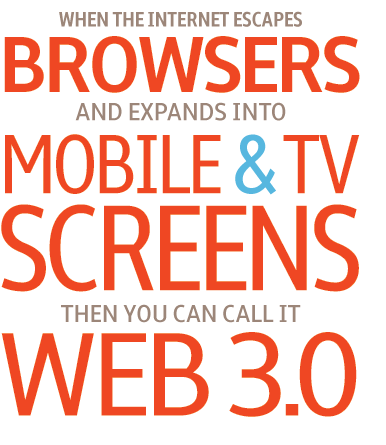
Jared Benson, Executive Creative Director and Christian Robertson, Visual Design Director at Punchcut were recently interviewed for Adobe’s Inspire publication.
The 9 minute video interview discusses Punchcut’s points of view on designing for people in a variety of contexts for a variety of consumer devices across mobile, television and other emerging electronics.
“Punchcut’s really committed” says Benson, “to understanding people’s changing lifestyles as new technologies are introduced. Designing for mobile is not just taking an experience and shrinking it down.”
Discussing television, Robertson asserts “Television is already such a shared experience. The question is how can a connected TV experience bring that natural desire to share right into the experience of watching TV to where it becomes a participatory experience, even with people who don’t happen to be in the same room with you.”
Enjoy.
Add this to digg, del.icio.us, etc.
All this week various Punchcut team members will be guest blogging at the Adobe XD blog, Inspire. Below is an excerpt only.

Gestures are taking over. With accelerometers being packed into more and more consumer devices (think Wii remote, iPhone, digital cameras and a host of other electronics) designers are using physical motion as a basic component of interaction design. This is great stuff; rather than being limited to simple pointing and selection, we can now create richer UI experiences that respond to a broader range of physical interactions, such as tilting, spinning, waving and shaking.
Author Gabriel White continues to articulate the design opportunities and considerations at the Adobe Experience Design publication, Inspire.
Add this to digg, del.icio.us, etc.
All this week various Punchcut team members will be guest blogging at the Adobe XD blog. Below is an excerpt only. Read the full piece at INSPIRE.
ABSTRACT // Mobile handsets are much more versatile tools for social networking activity than desktop PCs. While the market may not yet have provided a perfect vehicle for this aim, conditions are improving and the potential is undoubtedly there. Phones have distinct advantages over laptops and deskbound PCs. Mobile devices are not merely portable, but their media capabilities tend to be more readily accessible.
1. Mobile is with you when you’re in the moment (improved status)
2. Mobile devices are a creation and capturing tool (richness)
3. Location. Location. Location. (proximity and discovery)
4. Mobile is built for bite-sized consumption. (bite-sized consumption)
5. It’s a communication device (targeted)
6. Lends itself to quick-hit communication (easy)
Read my fully articulated piece on INSPIRE.
Add this to digg, del.icio.us, etc.
Adobe’s Experience Design Team has invited Punchcut to author a series of blog posts for their publication, INSPIRE.
Several of us will explore user experience topics ranging from mobile, television and convergence to social networking. The site will feature Punchcut blog posts the week of May 25 to 29, 2009.
First up is Peter Odum’s piece outlining the ways mobile beats desktop PCs as a social networking platform.
Add this to digg, del.icio.us, etc.

Call me a browser hater, but I’m looking forward to the design opportunities — custom applications and *fully branded experiences — possible when you throw out the browser and build the display piece into something more functional from scratch.
Mobile and TV will be the heroes of the post-PC, post-browser internet, and of course they’re already emerging with mobile browsers finally moving beyond WAP and with an exploding mobile app marketplace. But that potential is already being realized in post-browser desktop PC apps like iTunes, Evernote, Tweetie and a raft of AIR apps. Other niche uses like wi-fi cameras and devices that defy categorization like the beloved misfit, Chumby will have their place. Many brands have yet to understand the role the non-browser internet will play in their business and brands are likely to get caught up in TV widgets and mobile apps without a complete strategy. That’s okay. We can help.
I’m not really interested in defining Web 3.0. (I’ll leave that to Tim O’Reilly, although I’m a fan of the semantic web flavor of Web 3.0.) The more immediate future is the internet beyond the current PC- and browser-centric incarnation.
Further reading:
Check out this video presentation with Dave Zuverink. Dave is part of Adobe’s army of experience designers at Adobe XD. Dave gently reminds the world that web pages are just the display, not the content.
* I wrote a blog piece “Digital Branding Demands Custom Typography” discussing the branding benefits of creating your own apps on my Typophile blog.
Add this to digg, del.icio.us, etc.
The hub and spoke UI paradigm is a mobile classic (read: old and tired) and Apple, for all their industry leadership hasn’t escaped its limitations with the iPhone. Even with all the upcoming iPhone 3.0 features there’s nothing to help users with the cumbersome home screen that’s increasingly crowded with apps.
Recent statistics show the average iPhone user has downloaded about 40 iPhone apps from Apple’s App Store. Even if users rarely adopt the free apps they download (research by Pinch Media), they are still having to manage them. They’re likely dealing with 3 or more screens full of apps without any helpful way of sorting or grouping them. Continue Reading »
Add this to digg, del.icio.us, etc.
Pinch Media has analyzed 30,000,000 iPhone app downloads from the iTunes Music store and provides lots of insights into the pricing, timing, rankings of apps. Of note is the way usage drops off significantly for free apps (slide 12). Only 5% of users will open a free app after 30 days after downloading it. Makes you question the value of free.
While teh data is Apple iPhone-centric (based on how the store is designed for high turnover in the top rankings) the information should translate well for any app developer pursuing the emerging crop of app stores available for developers (i.e. the Ovi store and the Android market). Continue Reading »
Add this to digg, del.icio.us, etc.
Many of us at Punchcut have iphones or comparable devices, and we’re using them to keep ourselves entertained in downtime. The economy being what it is, we’ve also realized that downloadable games for our devices can be pretty cheap (or free) entertainment. But we still don’t like to spend money or time on apps only to be disappointed. Keeping this in mind, we’ve surveyed our office to find the games that people are actually playing, and that they feel are worth the investment, whatever that may be. Most of these are for iphone, but I’ve included a few games for other devices further down the list. Continue Reading »
Add this to digg, del.icio.us, etc.



